Rooting Trail:
Home: » Pig Artists » Art Museum » Artist Index » Grosz, George
Germany/United States, (1893-1959)
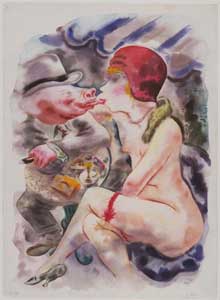
-
Circe
- (1927), watercolor, ink, and pencil on paper
- 25.8 x 19.2 in. (65.7 x 48.6cm.)
- Museum of Modern Art
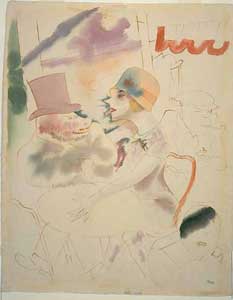
-
Circe
- (1925) watercolor on paper
- 24.25 x 19.25 in. (61.5 x 48.9 cm.)
- Hirshhorn Museum
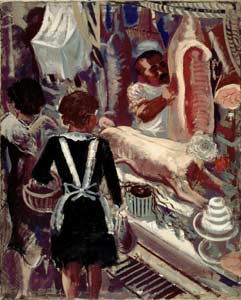
-
La Charcuterie
- [The Pork Butcher]
- (1931), oil on canvas
- 39.6 x 31.9 in. (100.5 x 81 cm.)
- Centre Pompidou
- Series: Der Weg allen Fleisches, 1924-31
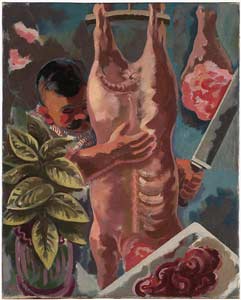
-
Metzgerei
- [The Butcher’s Shop]
- (1930), oil on canvas
- 33.1 x 26.8 in. (84 x 68 cm.)
- Private collection
- Series: Der Weg allen Fleisches, 1924-31
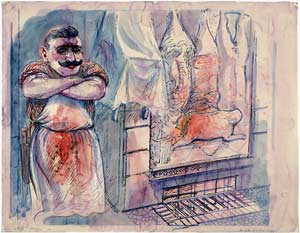
-
Fleischer
- [Butcher]
- (1928), watercolour, reed pen, pen and ink and gouache on paper
- 18.1 x 23.3 in. (46 x 59 cm.)
- Private collection
- Series: Der Weg allen Fleisches, 1924-31
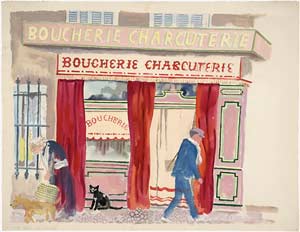
-
Boucherie Charcuterie
- [Butcher Shop and Delicatessen]
- (1927), watercolour and gouache on paper
- 19.1 x 24.7 in. (48.6 x 62.7 cm.)
- Private collection
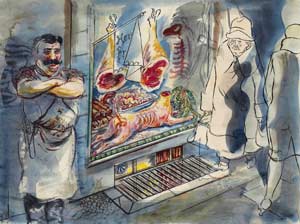
-
Fleischer
- [Butcher shop]
- (1930), gouache, watercolor and pen and India ink on paper
- 17.9 x 22.9 in. (45.4 x 58.1 cm.)
- Private collection
- Series: Der Weg allen Fleisches, 1924-31
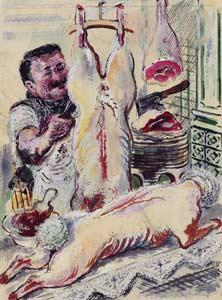
-
Berliner Fleischerei
- [Berlin Butcher]
- (1932), gouache, watercolor and pen and India ink on paper
- 23.6 x 18.1 in. (60 x 46 cm.)
- Private collection
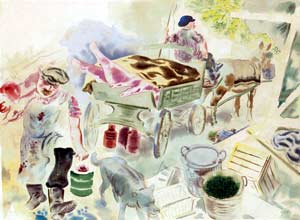
-
Fleischerwagen
- [Butcher wagon]
- (1929), watercolor on paper
- 20.4 x 27.1 in. (51.6 x 68.9 cm.)
- Private collection
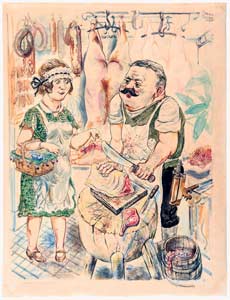
-
Der Metzger und das Dienstmadchen
- [The Butcher and the Servant Girl]
- (1928), ink and watercolor gouache
- 23.5 x 18.0 in. (60 x 46 cm.)
- Private collection
About the Artist
George Grosz (1893-1959) was a German painter, draughtsman and illustrator. He was a prominent member of the Berlin Dadaist art movement, and was considered a misanthropist and a Utopian. Grosz, was born Georg Gross but changed his name because he did not want a German name.
Grosz is particularly valued for his caustic caricatures, in which he used the reed pen with notable success. Although his paintings are not quite as significant as his graphic art, a number of them are, nonetheless, major works.
Bitterly anti-Nazi and anti-German after serving in WW I, Grosz left Germany in 1933 and lived in New York City as an art professor and painter until 1958. He became a United States citizen, but finally disillusioned there as well, he returned to Germany where he lived briefly until his death one year after his return. [DES-01/11]



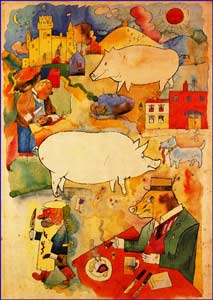








How Happy Hangs the Hog,
with a hook thru one fat leg,
he begs not now at Life’s back door
(black whore!)
she’ll throw him slops no more
for Butcher’s blade has chopped his flesh
and made poor Hog eternal blest
Hogsong 3/1965
A very fitting meditation on Grosz’s butcher series. Thanks for sharing, Casey!
— Dan